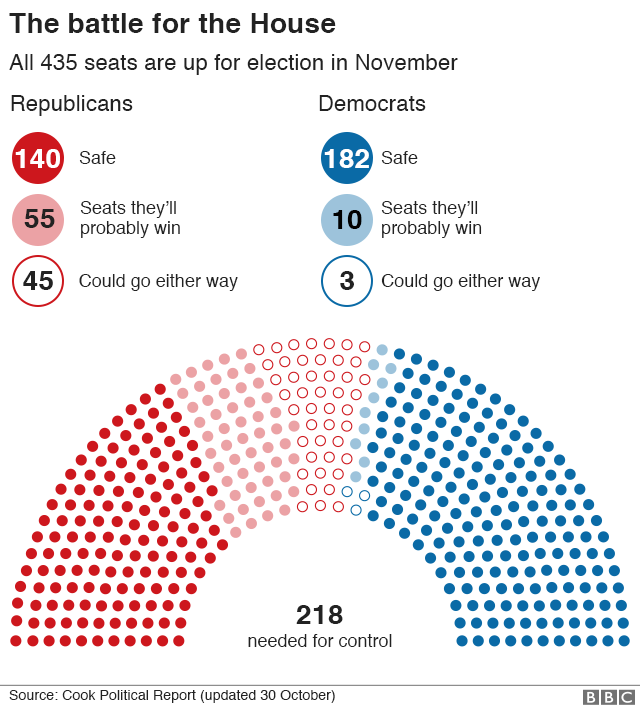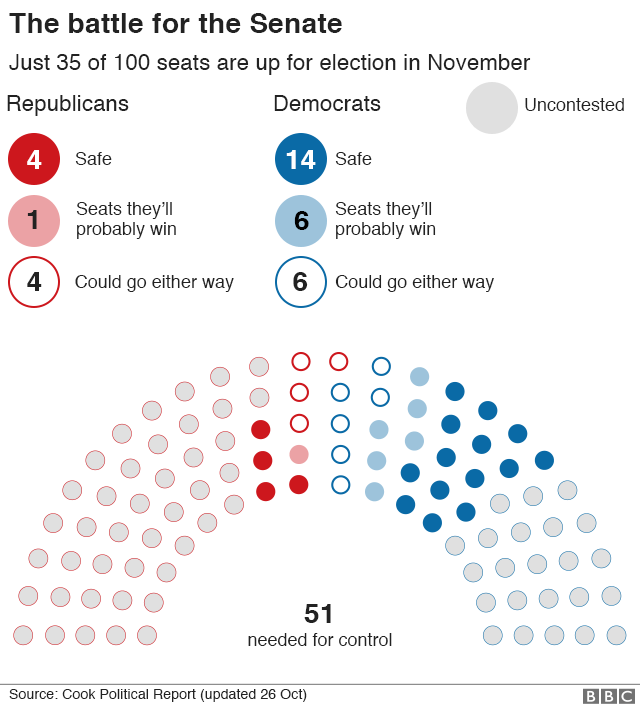A really simple guide to the US mid-term elections
Two years after Donald Trump was elected, American voters take to the polls again on 6 November for the mid-term elections.
This time they’re choosing new members of Congress, but how they vote could affect how the rest of Mr Trump’s presidency turns out.
If you want to know more, click here.
Who is being elected?
On 6 November American voters will elect members of the House of Representatives and the Senate, which together are called Congress.
Both houses of Congress are currently controlled by the Republican Party, which backs President Donald Trump.
The Democrats think they can win control of the House of Representatives this year by winning a majority of seats.
Doing so would let them block or delay the president’s plans by refusing to enact them.
All 435 seats in the House of Representatives are up for election.
If the Democrats want to take control of the House by having the most seats, they’re going to have to claim at least 23 from the Republicans.

That might not be difficult. A large number of Republicans are leaving the House this year, so a lot is up in the air.
The battle for the Senate, also currently controlled by the Republicans, will be worth keeping an eye on. There, 35 out of the 100 seats are being contested.
So what would happen if the Republicans held the Senate, but Democrats claimed the House of Representatives?
In a word: gridlock.
The risk of a government shutdown could increase hugely with the rival parts of government unable to agree with each other.
So who is going to win?
If you believe opinion polls, they say Democrats are ahead in many places.
And some experts think this year could see a so-called wave election, with the Democrats set to make major seat gains.
All the signs from the past point towards a defeat for President Trump.
President Trump’s low ratings in the polls could affect support for Republican candidates and energise the Democrats.

And let’s not forget the so-called “pink wave”. This year, more female candidates are running for election than ever before.
There are plenty of reasons we're seeing more women running.
Some candidates say it’s to make up for Hillary Clinton’s defeat in 2016, but anger at the president’s policies is the most common factor.
On the other hand, Republican support may hold up because the US economy is doing well.
What does it all mean for President Trump?
Donald Trump’s White House has been hit by one scandal after another.
Up to now, leading Democrats have avoided openly talking about removing President Trump or forcing him to resign.
But if this were to happen, a majority of members of the House of Representatives would have to vote for impeachment.
What would happen next? The president would then be put on trial by the Senate on charges of “treason, bribery, or other high crimes and misdemeanours”.
If a two-thirds majority of senators found him guilty, Mr Trump would be removed from office and replaced by Vice-President Mike Pence.
How big a deal would that be? Well, no president has ever been removed from office using the impeachment process.
A more likely outcome will see President Trump frustrated, with a Democrat-controlled House of Representatives blocking his plans.
And what happens next?
Once these elections are done, thoughts turn to the next presidential election in 2020.
As well as the elections for Congress on 6 November, 36 out of 50 state governors are up for election.
Of those 36, 26 are Republican.
When presidential campaigns get under way, governors often play a big part supporting their party’s candidates - by seeking donors or mobilising volunteers.
So a crop of new governors in the mid-terms could have a major effect on presidential campaigning in 2019 and 2020.



